Augustan Rome Final
1/82
There's no tags or description
Looks like no tags are added yet.
Name | Mastery | Learn | Test | Matching | Spaced |
|---|
No study sessions yet.
83 Terms
First Settlement
27 BCE
Augustus returns power to the Senate but maintains control over key provinces and the military forces
Essentially promised to restore Rome back to a Republic, but it was the beginning of the Roman Empire
Second Settlement
23 BCE
Augustus renounced consulship but gained maius imperium and tribunicia potestas without actually becoming a tribune
Maius Imperium: Highest level of imperium (could override everyone)
Tribunica Potestas: Propose laws to the senate, veto laws, Sacrosanct, etc
Family Laws
17 BCE
Unmarried individuals were denied inheritance rights and access to public entertainment
Punished adulterers with banishment
Fathers were allowed to kill a daughter and her lover if caught in the act
Husbands were legally required to divorce adulterous wives or face penalties themselves
Those who produced 3 male sons were granted high regard and privileges
Women could gain legal independence once they birthed a certain number of children
Ludi Seculares
17 BCE
Religious games and festivals to symbolize a new golden age under his rule
Ara Pacis
13 BCE
Celebrate the peace and prosperity brought by Augustus
Located in the Campus Martius
Organization of Rome into Regiones
7 BCE
Divided Rome into 14 Regiones
Each region was divided into vici (neighborhoods)
Each vicus had its own local officials (Vicomagistri) and shrines (Lares Compitales)
Temple of Mars Ultor
2 BCE
“Mars the Avenger”
Augustus promised to build the temple after defeating Brutus and Cassius, but was delayed until his reign was fully consolidated
Death of Augustus
14 CE
His final words, according to Suetonius:
To the public: “I found Rome a city of bricks and left it a city of marble.”
To friends: “Have I played my part well? Applaud as I exit.”
Buried in the Mausoleum of Augustus
Senate deified him → Divus Augustus
Aeneas
Legendary Trojan hero
Considered the founder of Rome
Named in Virgil's "Aeneid" as the ancestor of the Romans
Symbolizes duty and piety in Roman culture
Anchises
Venus’ lover, Aeneas’ father
Dies in Sicily
Ascanius
Travels with Aeneas
Founded Alba Longa - birthplace of Romulus and Remus
Also called Lulu / Julus
The Gens Julia (clan of Julius Caesar) claims descent from him and ultimately the goddess Venus
Turnus
Fiancé of Lavinia, becomes Aeneas’s enemy
Refused to give up Lavinia → war
Killed by Aeneas
Mezentius
An Etruscan King who allied with Turnus
Known for cruelty and impiety (mocks the gods)
Defeated by Aeneas in battle
Dies seeks vengeance for his son Lausus, who was trying to defend his father and was ultimately killed by Aeneas
Aeneas was moved to pity
Latinius
King of Latium, Lavinia’s father
Receives Aeneas with goodwill; sees him as the man fated to marry Lavinia
Tries to avoid war
Evander
King of Pallanteum (site of future Rome)
Offers an alliance to Aeneas against Turnus
Helps Aeneas arrange an alliance Etruscans
Pallas
Son of Evander
Becomes Aeneas’s protege and is killed by Turnus
Euryalus and Nisus
Close friends serving under Aeneas
Undertake a daring night raid on the Rutulian Camp (Book 9)
Aeneas was away seeking allies, and the Trojan camp was under siege by Turnus and the Rutulians
Plan to infiltrate the Rutulian camp and kill
Successfully breach the camp and slaughter many sleeping Rutulians
Euryalus starts taking the spoils of war, and the gleaming helmet he took gives away their position
Both were ambushed and killed, heads displayed on pikes at the Trojan camp
Augustus
First Roman emperor and heir of Julius Caesar
Achievements
Ended civil wars, established the Principate
Launched massive building programs (Forum of Augustus, Ara Pacis, etc.)
Family laws and religious revivals
Linked his rule to Rome’s divine destiny
M. Agrippa
Augustus’s closest friend, general, and son-in-law
Achievements
Won the Battle of Actium
Oversaw building projects
Backbone of Augustus’ military and civic success
Parthians (iranians)
From the Eastern empire, Rome’s greatest rival
Roman-Parthian War (54 BCE)
Humiliated Rome with the death of Crassus in 53 BCE
Captured Roman Aquila
Returned Roman standards (aquila, emblem of the golden eagles, most prestigious) to Augustus
Livia Drusilla
Augustus’ wife, mother of Tiberius
Model of Roman matronly values
Powerful advisor
Tiberius
Augustus’ stepson and successor
Emperor 14-37 CE
Rule: Expanded the empire; known for a more repressive, suspicious reign
Considered a bad emperor
Eventually resigned rule and moved to the island of Capri
Claudius
Emperor 41-54 CE
Conquered Britain
Capable emperor
Mocked for his physical disability
Allegedly died from poison
Nero
Emperor 54-68 CE
Infamous for extravagance, artistic obsessions, and cruelty
Accused of murdering his mother and wives
Persecuted Christians
Built the “Golden House”
More interested in his own entertainment than well well-being of the empire
Blamed for the Great Fire of Rome
Allegedly used it as an opportunity to bypass the senate and rebuild the city and construct his new palace, the Domus Aurea (“golden house”) to his liking
Blamed the Christians
Romans eventually rebelled, declared him a public enemy. Nero fled and eventually committed suicide
Agrippina the Younger
Mother of Nero, wife of Emperor Claudius
Secured Nero’s succession
Later murdered by Nero when she became inconvenient
Julia the elder
Only biological child of Augustus (with Scribonia)
Married Agrippa
Gaius Caesar, Lucius Caesar
Exiled by Augustus for adultery and moral scandals
Gaius and Lucius Caesar
Adopted grandsons of Augustus
Groomed as successors
Early deaths
Mesalla Corvinus
Prominent Senator, general and literary patron
Supported the Augustan regime
Ties with poet Propertius
Maecenas
Close advisor to Augustus and major patron of literature
Supported horace, vergil, propertius
Helped craft the cultural propaganda that supported Augustus
Horace
Works: Odes, Epodes, Satires, and Carmen Saeculare
Celebrated Augustan peace and moral reform
Balanced praise with subtle personal themes
Vergil
Works: Ecologues, Georgics, and Aeneid
Aeneid mythologized Augustus’ rule, portraying Rome’s destiny and divine favor
Foundation of Augustan literary propaganda
Propertius
Works: Elegies (Books 1-4)
Combined love poetry with politics and art
Less overtly supportive of Augustus than Horace / Vergil
Catullus
Works: Carmina
Pre-Augustan; famous for intense and personal love poetry
Tibullus
Works: Elegies
Love poetry focused on the ideal of simple rural life
Associated with Messalla Corvinus
Sulpicia
Works: Short poems included in the TIbullus books
Only known Roman female poet whose work survives
Offers a female perspective on love poetry - rare and valuable
Ovid
Works: Amores, Ars Amatoria, Metamorphoses, Tristia
Often pushed boundaries of Augustan morals
Exiled by Augustus in 8 CE for “a poem and a mistake”
Vergil’s Aeneid (Books 6,7,8,12)
Book 6
Aeneas arrives in Italy and consults the Sibyl a priestess at Cumae
Travels to the Underworld to seek guidance from his father, Anchises
Sees the river Lethe (souls waiting for rebirth) and the famous future Romans
Anchises reveals Rome’s glorious destiny
Book 7
Aeneas reaches Latium; King Latinus offers his daughter Lavinia in marriage
Juno, still opposing Aeneas, incites war by rousing Turnus and the native Italians
Aeneas prepares for battle
Book 8
Aeneas visits King Evander who agrees to help
Vulcan, at Venus’ request, forges Aeneas’ armor, including a shield that shows scenes of Roman history
Like Augustus victory at Actium
Vergil ties Aeneas’ mythic struggle directly to Augustus reign
Book 12
Aeneas and Turnus engage in single combat
Turnus is defeated and begs for mercy
Aeneas in furor kills Turnus
Furor vs Pietas
Rome’s peace and empire are born through bloodshed
Horace, Carmen Saeculare
Context: commissioned for the Ludi Saeculares during Augustus’s reign
Content: A hymn to Apollo, Diana, Juno, and Jupiter
Praises Augustus and Rome’s prosperity, asking the gods to bless Rome’s future
Themes:
Renewal and divine favor: Celebrates a new golden age
Moral and Civic Virtue: Aligns with Augustus’s religious and moral reforms
Propaganda: Presents Augustus as chosen by the gods to lead Rome into peace and glory
Propertius (Elegies - 2.1, 2.15, 2.16)
2.1: The role of the poet
Content:
Propertius defends his choice to write love poetry rather than an epic about Augustus’ military exploits
Themes:
Poetic identity: Asserts that love poetry has value alongside patriotic epics
Ambivalence: Shows both respect for Augustus and a desire to focus on personal themes
2.15: Love and Desire
Content:
Describes a passionate night with Cynthia (his lover)
Vividly sensual and celebratory of physical love
Themes:
Pleasure and Indulgence: Pushes back against the era’s moral rigidity
2.16: Longing and Absence
Content:
The poet expresses desperate longing for Cynthia when she is away
Ovid (Amores- 1.1, 1.4)
1.1: The Poet & Love
Content:
Ovid begins by announcing a war-like epic, but Cupid steals a foot from his verse, forcing him into love poetry
Themes:
Humor & Irony: Playful subversion of epic conventions
Love as Battle: Positions love as its own kind of heroic struggle
1.4: Seduction at Dinner
Content:
Ovid gives explicit instructions to his lover during banquet - how to exchange glances and communicate in secret
Themes:
Wit & Mischief: Flirty and light-hearted
Lethe River
River of forgetfulness in the Underworld; Souls drink to erase past memories before rebirth (Book 6)
Ekphrasis
Vivid literary description of art; famous in Aeneas’ shield scene (Book 8)
Furor
Rage, chaos, and violence
The destructive force Aeneas must control to fulfill destiny
Pietas
Duty to gods, family and country
Aeneas’ defining virtue
Forum of Augustus
Monumental space showcasing Rome’s greatness; featured statues of heroes and the Temple of Mars Ultor
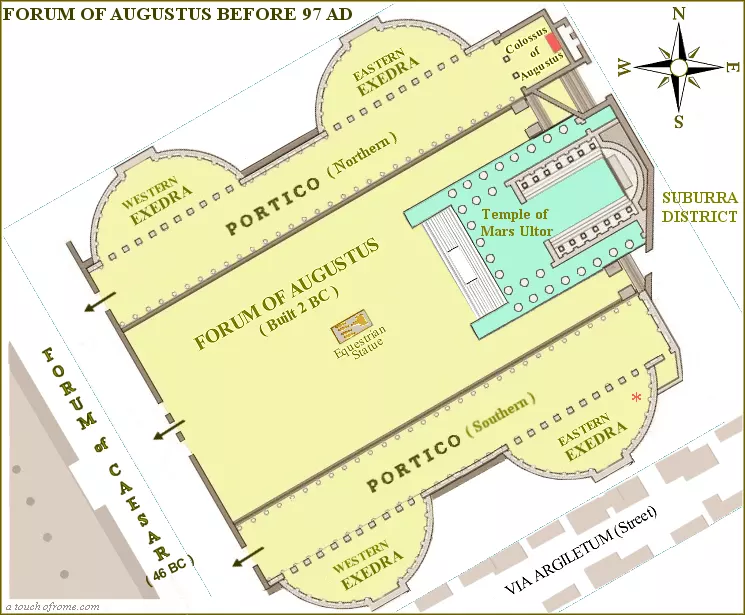
Exedrae
Semicircular Niches in Roman Architecture
Housed statues of summi viri in the Forum of Augustus
Summi Viri
Statues of Rome’s great men (founders, heroes) honoring Roman history in public spaces
Sol Apollo
Roman sun god
Associated with Augustus, symbolizing divine favor and enlightenment
Vicomagistri
Neighborhood officials who managed local shrines and festivals
Lares Compitales
Guardian deities of crossroads
Honored in local roman neighborhoods
Genius
A person’s or place’s protective spirit
Augustus’ genius was publicly worshipped
Temple of Divus Julius
First temple to deify a Roman (Julius Caesar)
Tied Augustus to divine heritage
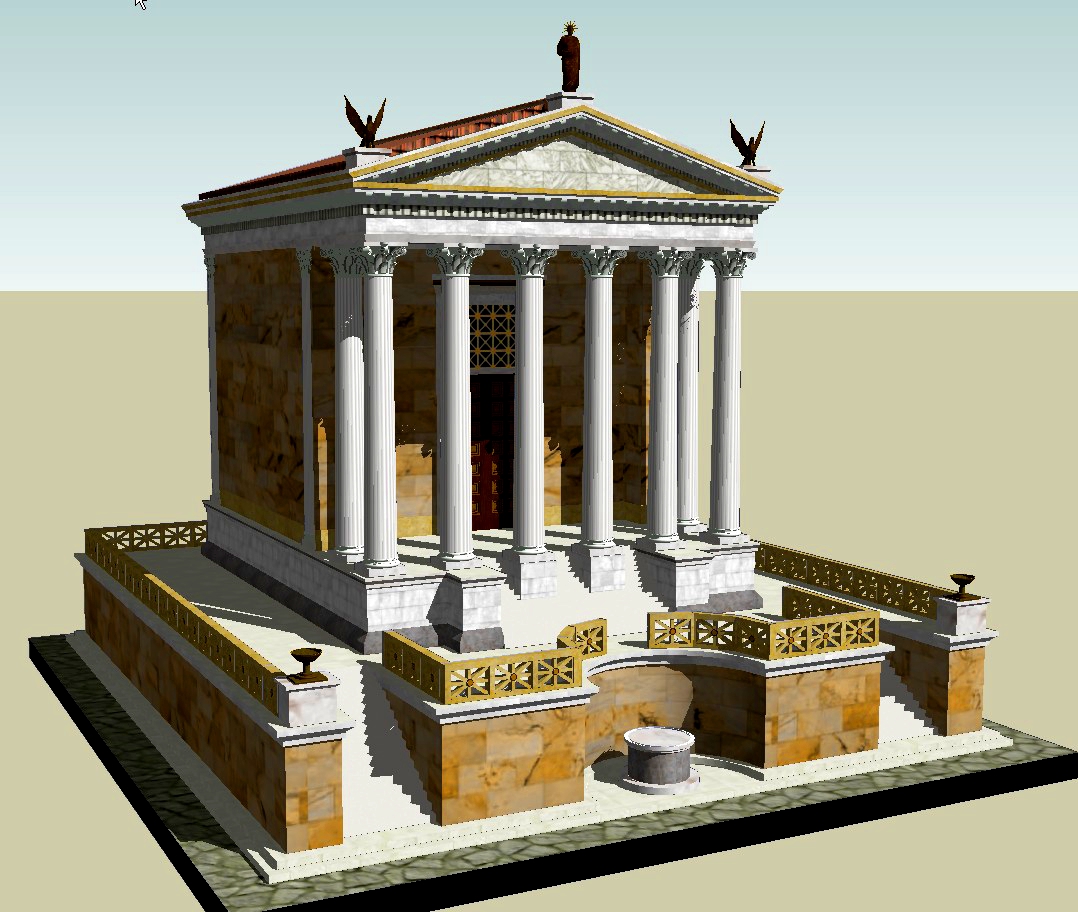
Horologium
Giant sundial in Campus Martius
Aligned with the Ara Pacis
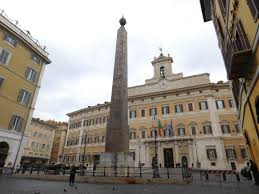
Gnomon
The shadow-casting arm of a sundial; Horologium’s centerpiece
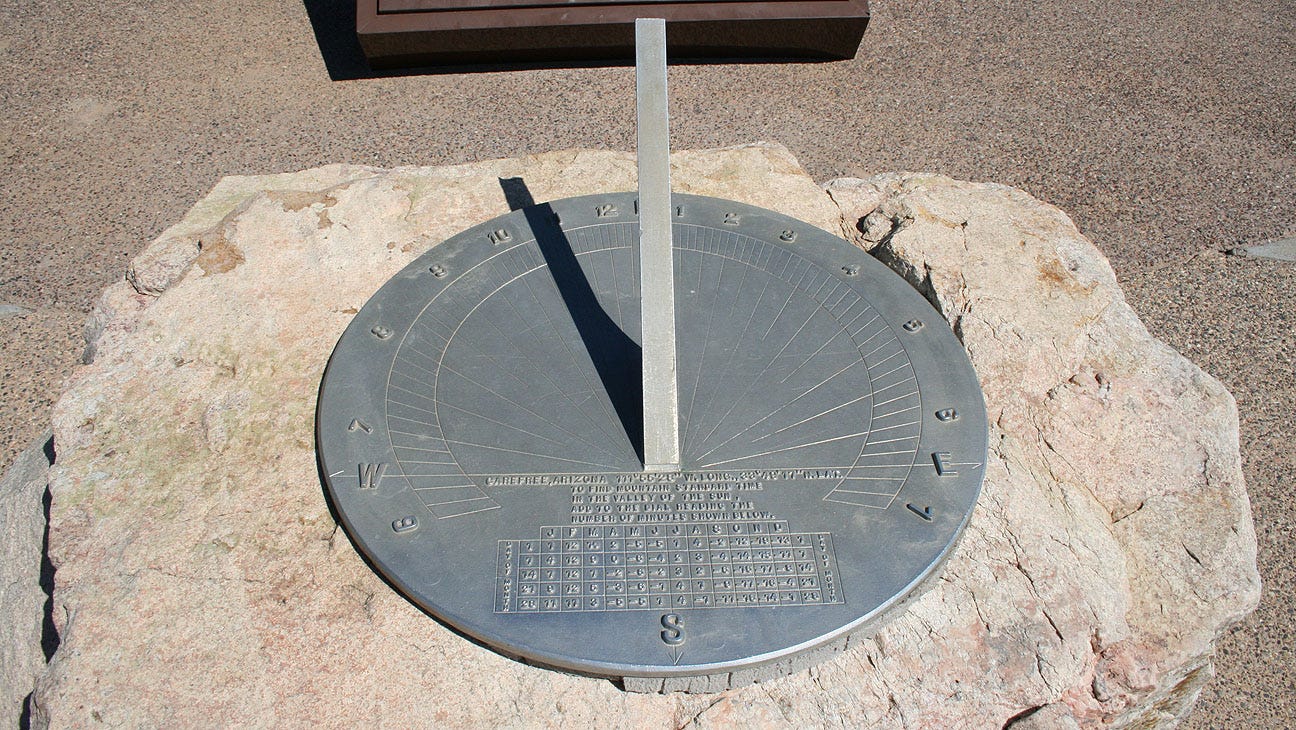
Ara Pacis North Processional Frieze
A line of figures participating in a religious procession, likely for the altar’s consecration
Figures are dressed in togas and include rome’s political and religious elites
Children appear alongside adults → reinforce Augustus push for family values
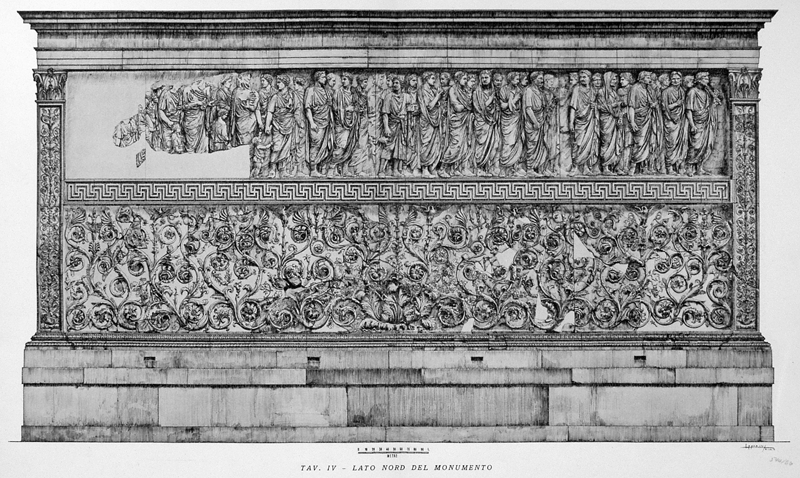
South Processional Frieze
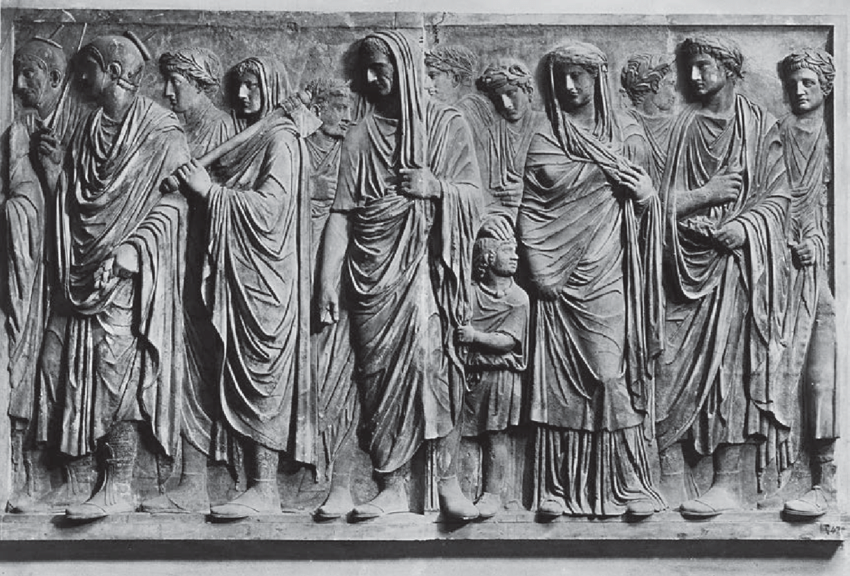
First West Mythological Frieze
Aeneas sacrificing panel

Second West Mythological Frieze
Romulus and Remus
Shows them being suckled by the she-wolf with Faustulus the shepard that found them nearby
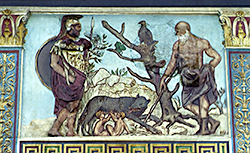
First East Mythological Frieze
Tellus
Shows Tellus (earth), Pax (peace), or Italia cradling twin babies surrounded by symbols of fertility and abundance
Animals, birds, and lush plants
Sea and sky personifications, representing the harmony of land, sea and air
Emphasizes the natural prosperity and peace brought by Augustus’ rule → Pax Romana
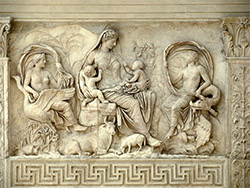
Second East Mythological Frieze
Roma
Depicts Roma, personification fo Rome, seated on a pile of captured weapons and armor
Appears strong and serene, holding a spear, symbolizing military might and victory
Peace through strength
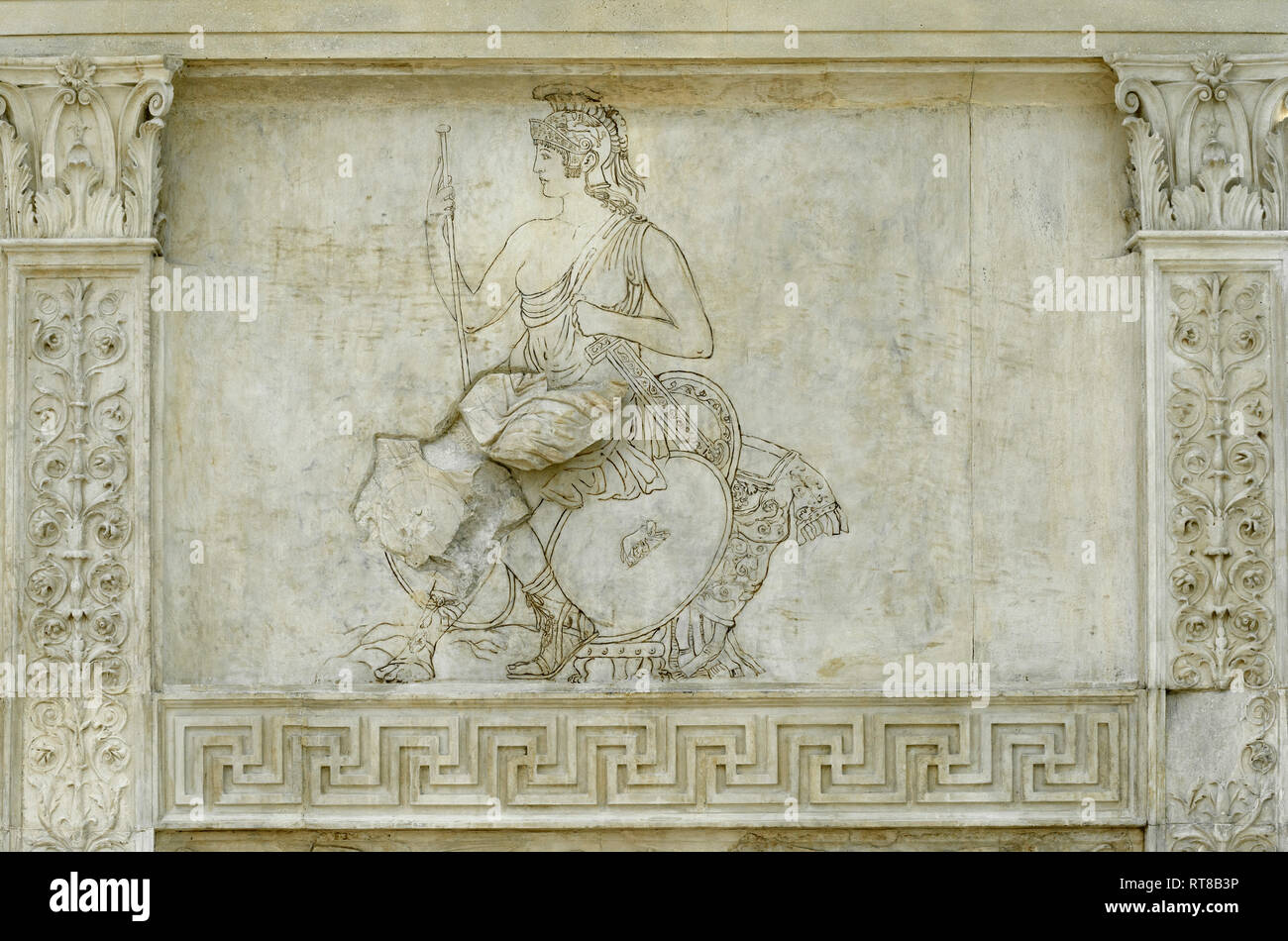
Elegiac Poetry
Love focused Roman poetry with alternating hexameter and pentameter lines
Propertius, Ovid
Amor vs Roma
Ovid’s playful theme: love (amor) distracts from civic duty (Roma)
Roman Odes
Horace’s formal poems glorifying Rome and Augustus’ achievements
Ars Amatoria
Ovid’s “Art of Love”, witty guide to seduction – controversial in Augustus’ moral climate
Ovid Exile
Banished in 8 CE to Tomis
Famously cited a “poem and a mistake” as the cause
Likely linked to the Ars Amatoria
Pax Romana
“Roman Peace” under Augustus
Romanization
The spread of Roman culture, law, and language across conquered provinces
Tropaeum Augusti
Victory monument in Gaul celebrating Augustus’ conquest of the Alps and tribes
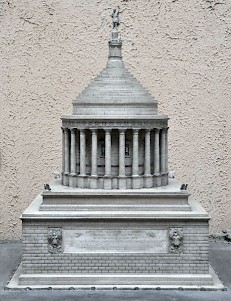
Forum of Merida
Example of provincial Roman architecture; reflects imperial influence
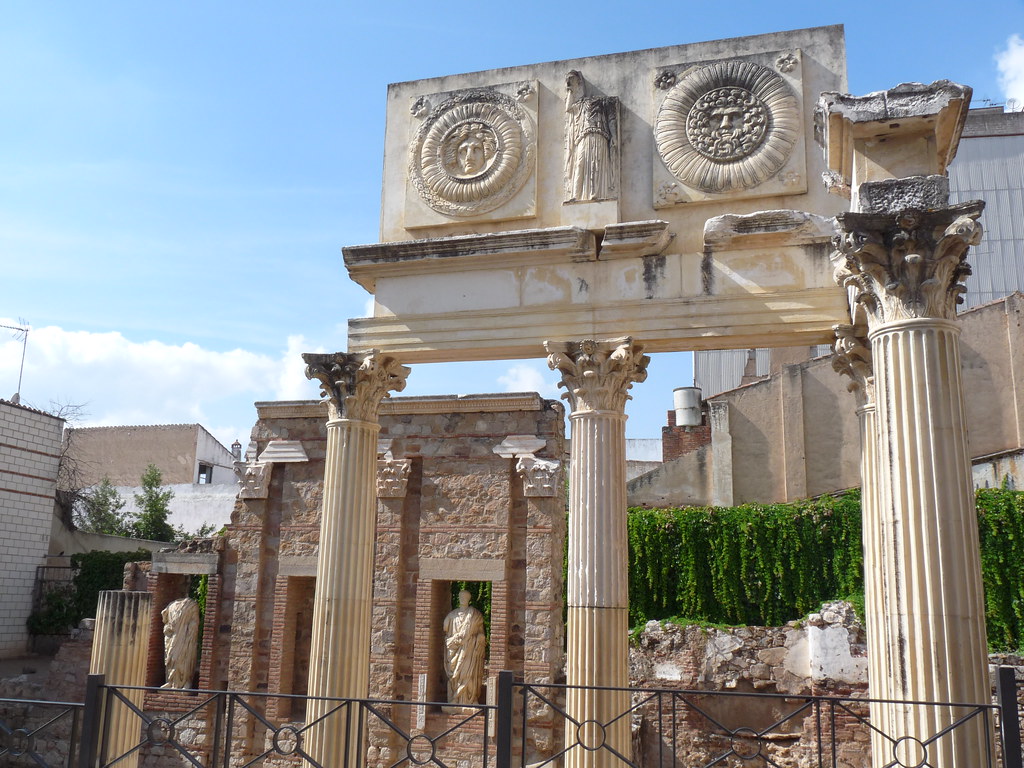
Altar of the gens Augusta
Associated with the imperial cults
Shows Aeneas dragging Ascanius and Anchises
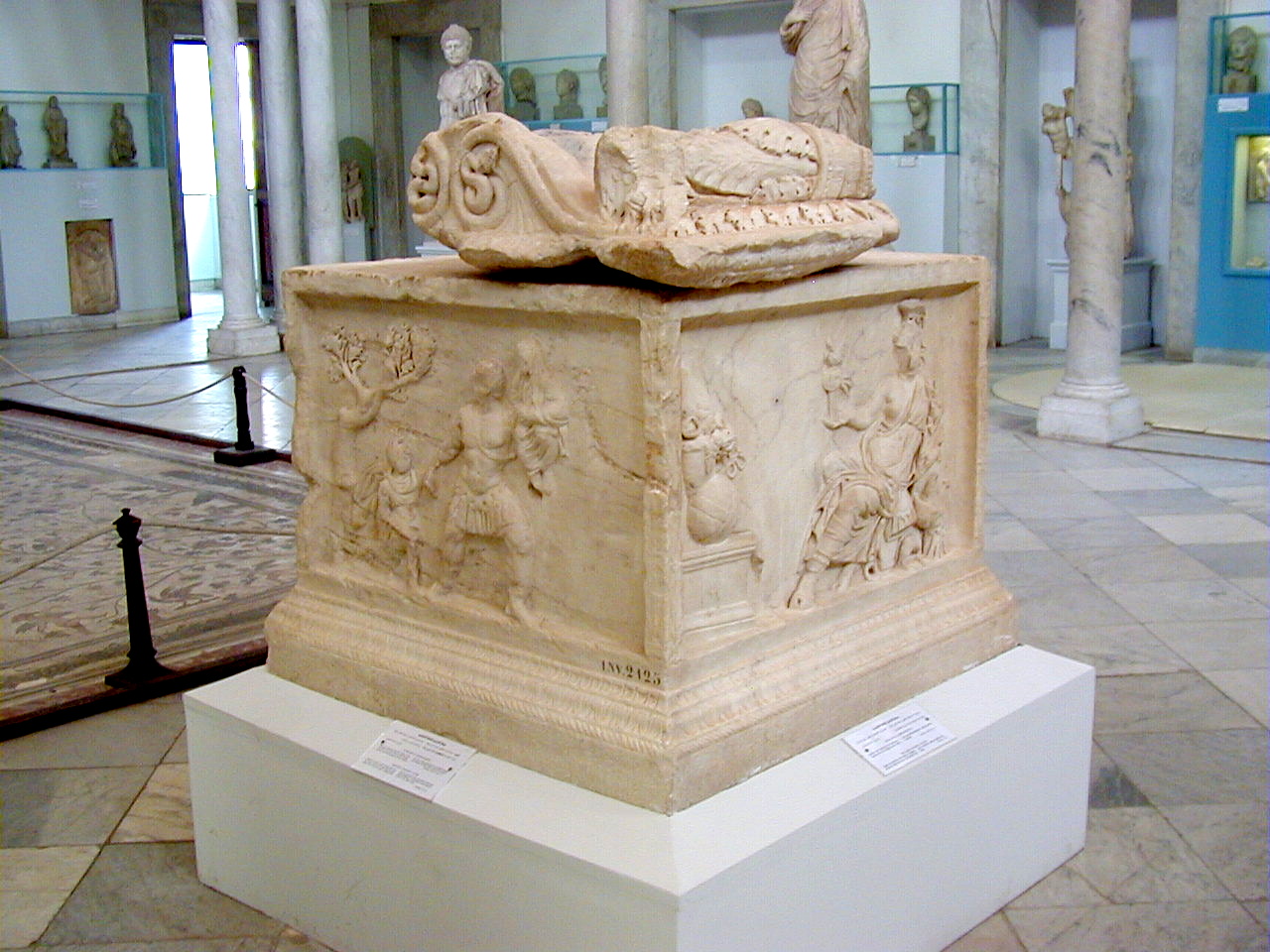
Royal Mausoleum of Maurentania
Tomb blending Roman and local styles
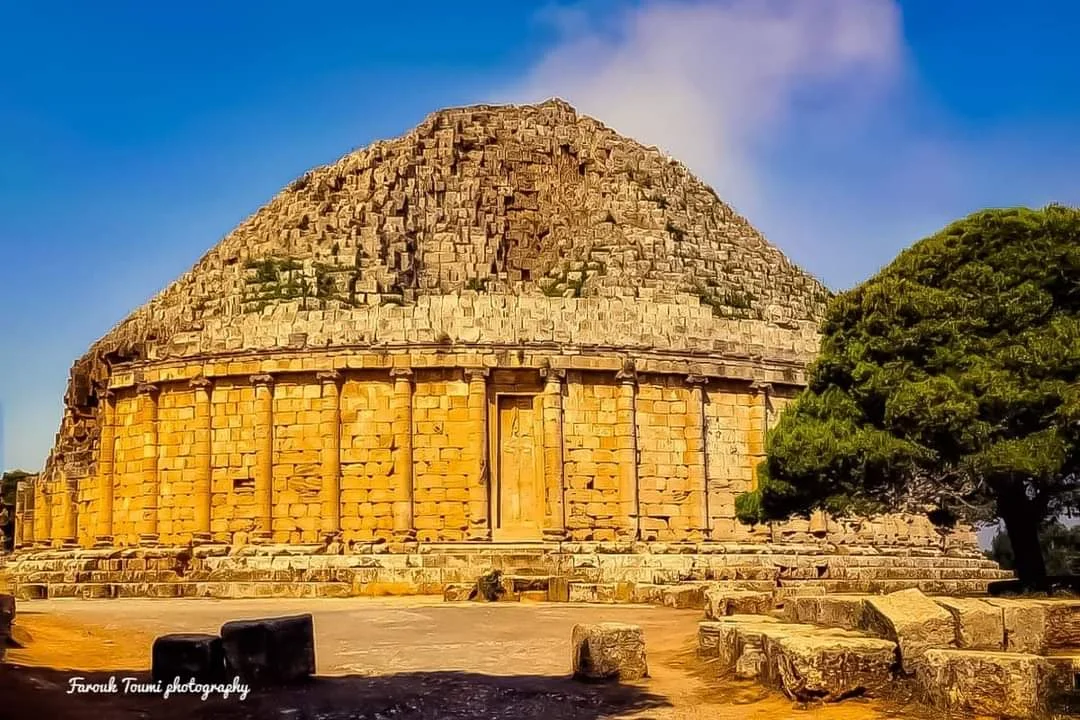
Imperial Protraiture
Statues and busts of emperors; combined realism with idealism to project power
Apotheosis
The process of becoming a god, Augustus was deified after death
Gemma Augustea
Intricately carved cameo showing Augustus as Jupiter-like figure, symbolizing victory and divinity
Seated next to Roma
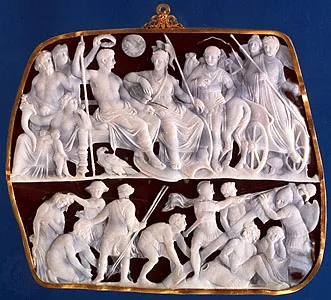
Syncretism
Blending of different religious and cultural practices, seen in provincial Roman cults
Lares and penates
Household gods
Lares = guardians of the home
Penates = protectors of storerooms
Sebasteion of Aphrodisias
Provincial temple complex glorifying the imperial family
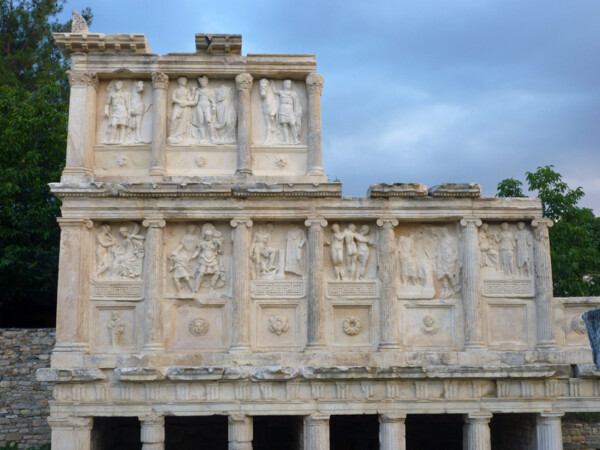
Building of Eumachia
Large building in Pompeii
Associated with prominent woman, reflects elite female influence
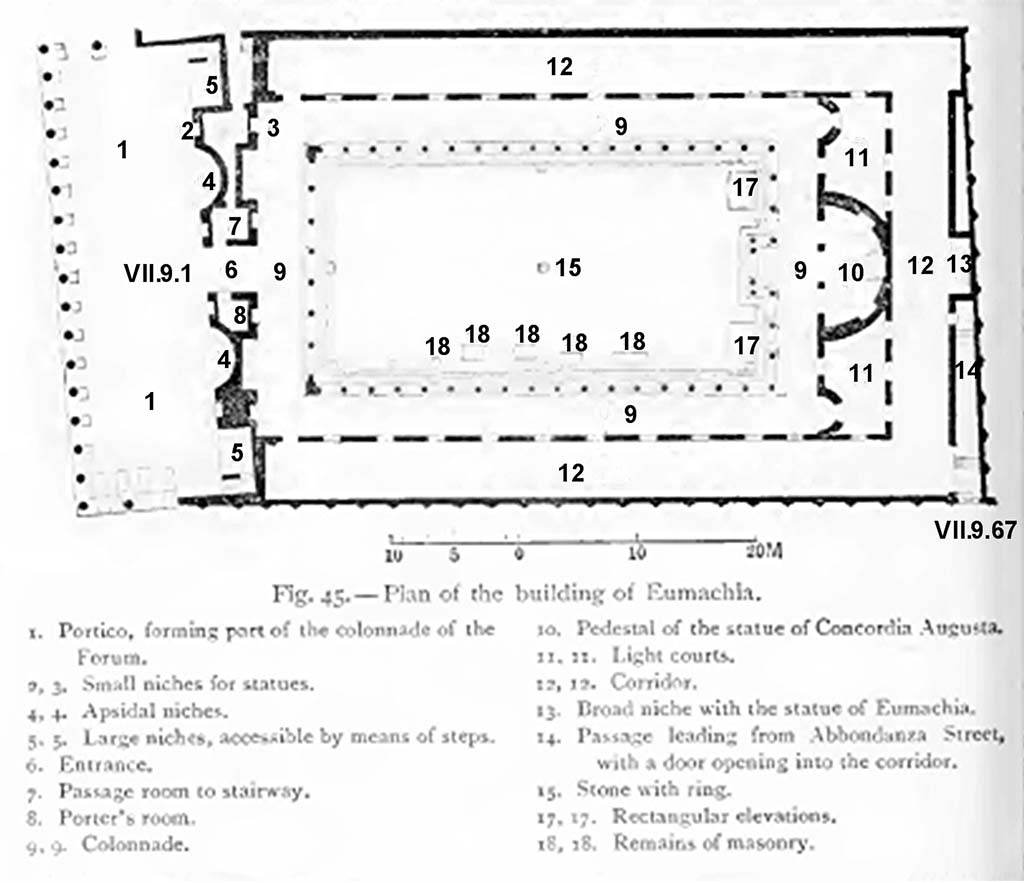
Julio-Claudian Emperors
Dynasty after Augustus: Tiberius, Caligula, Claudius, nero
Maintained and evolved the empire
Imperial funeral
Large public events with processions, cremation, deification rituals
Procession:
Body was displayed on a a golden bed with senators, soldiers, priests, and family members in the Forum Romanum
Body lay in state for several days, often in the emperor’s home
Public eulogy praising the emperor’s achievements
Cremation
Body is placed on a massive funeral pyre outside the city often in the Campus Martius
After the pyre was lit, an eagle (aquila) was released, symbolizing the emperor’s soul ascending to the heavens
Deification
If the senate decreed, the emperor was formally deified (apotheosis) after the ceremony, joining the ranks of Divi (gods)
A temple might be erected to honor them
Showed continuity and stability
Strengthend the imperial cult which worshipped the spirits of the deified emperors
Allowed the populace to participate in imperial rituals, reinforcing loyalty and unity
Domus on the Palatine
Augustus’ residence, simple yet symbolic of his position as princeps
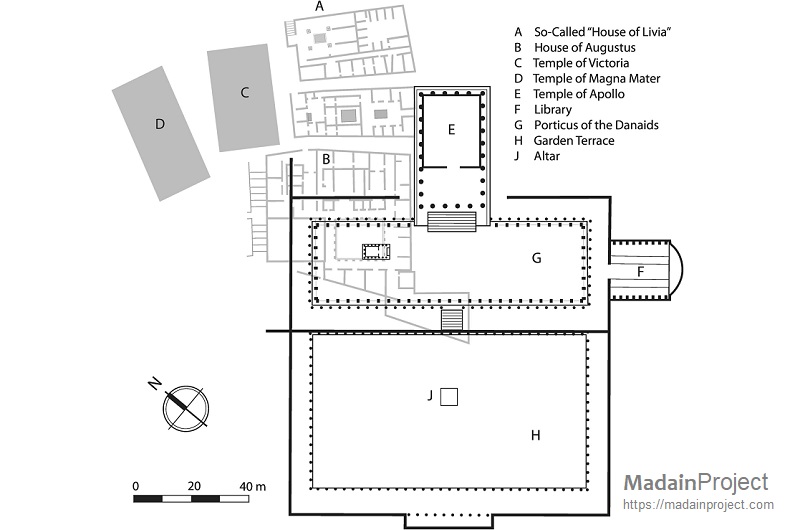
Furor in the Aeneid
Introduction:
Concept of furor as a force of rage, chaos, and destruction in roman thought
Thesis Statement: In the Aeneid, furor symbolizes the destructive forces that threaten both personal self-control and political stability; Vergil uses Aeneas’ journey to explore the tension between chaotic rage and the Roman virtue of pietas.
BP 1:
Furor first appears through Juno’s wrath, which sets the plot in motion
Juno’s hatred of the Trojans and her manipulation of events (instigating the war in Latium)
Shows how destructive passion of the gods affect humans, causing conflict and delaying destiny
BP 2:
Aeneas is defined byn pietas but is repeatedly tempted by personal passion and anger
His love affair with Dido (books 1-4); how desire distracts him from destiny
His grief and rage over the death of Pallas
Shows how even the model of Roman virtue struggles with furor
Conclusion
Vergil’s ending makes readers question whether true peace is ever fully attainable or if furor is an eternal part of human existence
The myth of Augustus on the Ara Pacis
Introduction
Art and architecture in Augustan rome wasn’t just decoration but also tools of imperial propaganda
Ara pacis was a celebration of augustus’s achievements
Thesis Statement: The Ara Pacis uses mythological imagery—Aeneas, Romulus, and divine figures—to create a visual myth of Augustus as the rightful heir to Rome’s founders, blending history and legend to legitimize his power and promote his vision of a new golden age.
BP 1:
Aeneas serves a direct mythical parallel to Augustus
Depicts Aeneas performing a sacrifice, embodying pietas
Emphasized this virtue and aligned himself with Aeneas’ dedication to the well-being of Rome
Represents him as Rome’s founder and divine ancestor
Divine lineage
Aeneas is son of Venus
And Augustus is adopted by Julius Caesar who claims descent from Venus
BP 2:
Romulus and Remus Scene
Reinforces Rome’s legendary origins
The she-wolf with Romulus and Remus, overseen by Mars
Evokes themes of strength and divine favor
Implies that Augustus is the new guardian of Rome’s legacy
Situated as a bridge between Rome’s legendary origins and contemporary resurgence
BP 3:
Tellus
Symbolizes the prosperity Augustus claims to bring
Peaceful earth goddess with animals, crops, and children
Mythically ties Augustus rule to fertility, harmony, and cosmic balance, reinforcing the idea of a golden age
Conclusion
Ara pacis uses myth to craft a narrative of Augustus as Rome’s destined savior and renewer
Turned Augustus’ regin into a timeless myth and he was able to anchor his poltical power in Rome’s deepest identity.